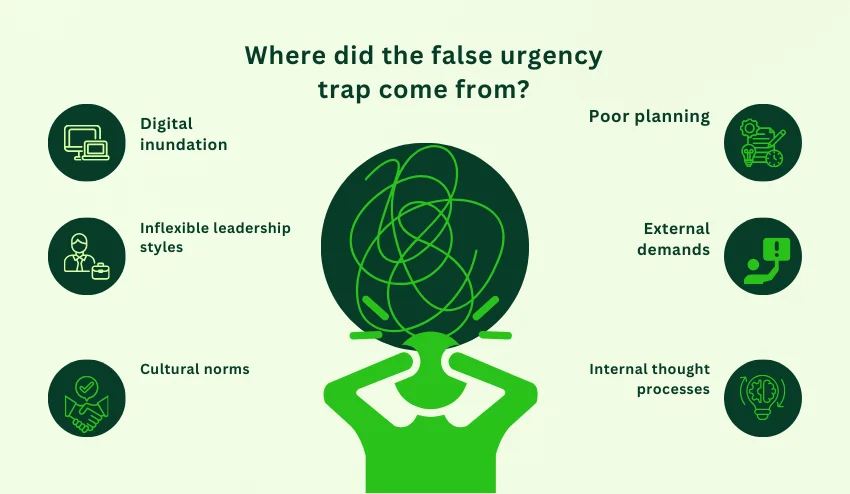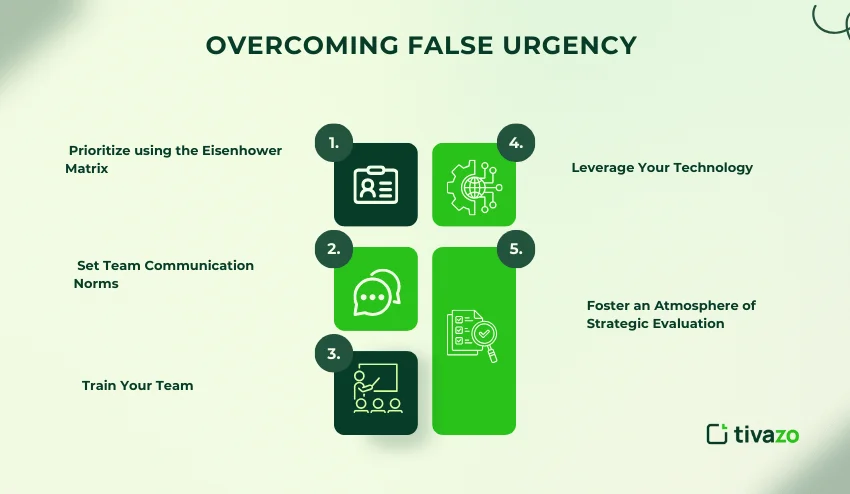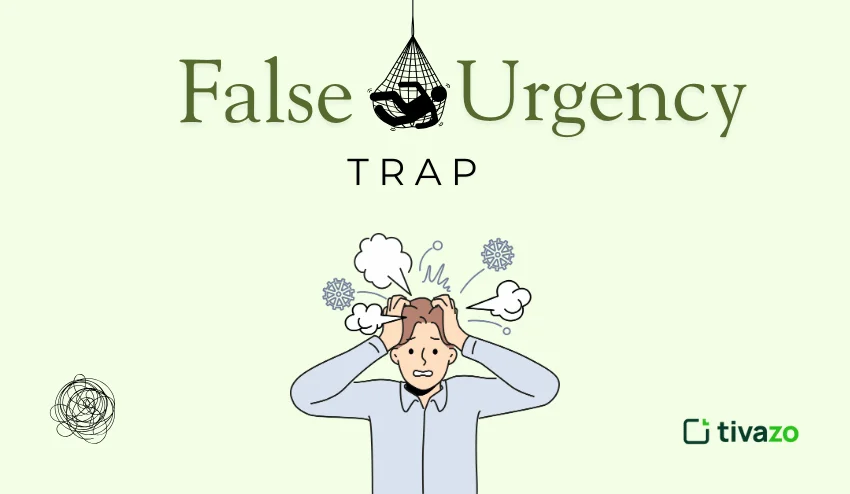Have you ever found yourself in a constant state of “urgency,” but weren’t sure if it was real? Not sure where the stress was coming from? Do not worry, I got you!
In today’s fast-paced workplace, many professionals fall into the false urgency trap, where everything is urgent but very little is important. Some urgency is real urgency, but some urgency is manufactured, caused generally by an unreasonable external pressure, unclear priorities, or poor time management, just to give you a few examples.
The false urgency trap can sap energy, raise stress, and frequently be a precursor to burnout, yet produce little real value. Observing how to recognize, respond, and navigate the false urgency trap is a key to enhancing productivity and well-being at work.
What’s Meant by the False Urgency Trap?
When people or team members always feel a sense of urgency about everything they do, and act upon that sense of urgency, even if there is no actual urgency (and therefore no real importance), they can fall into the false urgency trap. They can end up performing busy work – untiered work that absorbs time, but adds really little long-term value.
Simply put, the false urgency trap means, “everything feels urgent, but nothing is truly important“.
This trap can happen at any workplace: small teams, large organizations. More often than not, it is a byproduct of poor planning, unclear priorities, or cultures where a sense of busyness equals productivity. Employees feel they need to reply to every email as soon as it arrives, they feel a need to attend all meetings (not realizing they can just leave), and they end up performing tasks that matter nothing at all. Eventually, this way of behaving not only will reduce the total efficiency of the organization, but it can also increase employee stress and burnout. Being aware of the false urgency trap is the necessary first step toward being a more focused, intentional, and productive workplace.

A few examples of false urgency
Below are some examples of the false urgency trick for some common workplace scenarios:
| Scenario | False Urgency Example | True Urgency Example |
| Emails | A colleague indicates every email is “urgent”, including simple updates. | A system outage notification needs immediate IT response. |
| Meetings | Daily “Team Check-Ins” are regularly scheduled and contribute nothing to progression. | A change from a client informing delivery of a project would need to be modified and provided urgently. |
| Tasks | Rushing to complete reports that nobody even looks at. | Compliance document submitted to support a hard deadline/consequence by law. |
| Office Requests | A Manager who regularly asks you for “a quick update” five times a day | Papers to be finalized before the board presentation |
The examples above illustrate how the false urgency trap creates overwhelmed, stressed workers and contributes little to nothing to the workplace. Employees can fall into the phase of continuous reacting, with little or no proactive thought or plan for their day. Employees are wasting effort and productive time, which leads to burnout. False urgency often looks like productivity because it promotes action. Becoming aware of these patterns helps teams understand what is really important, what they should prioritize as important, and how they will allocate the time needed to do those things. Organizations can develop healthier, more efficient workplaces when they know the pattern and difference between real and false urgency.
What is a false sense of urgency at work?
A false sense of urgency at work occurs when workers face so many demands and pressures that they feel psychological urgency to get everything done. False urgency arises from ambiguity, poor leadership, or a culture that confuses speed with effectiveness.
Signs of a false sense of urgency:
- Jumping between tasks and losing focus
- Feeling exhausted while not making any substantial progress
- Equating activity, or being “busy”, with productivity
- Exacerbating stress and burnout over time
- Focusing more on being busy, rather than achieving results
- Lower job satisfaction and morale
- Inability to focus on strategic or relevant goals
Identifying your patterns can help you break the cycle of false urgency that can stifle your work life. Finding ways to make work healthier and more productive can be established.
Where did the false urgency trap come from?
The origins of the false urgency trap come from modern workplace culture as well as several aspects of that culture:
1. Digital inundation
With emails, instant messages, and notifications continuously pinging and arriving, employees find themselves in a situation where they feel compelled to respond as a first priority. This creates a sense that everything is urgent.
2. Inflexible leadership styles
Some executives equate speed with productivity; their mantra becomes: react quickly! Get it done! This pushes teams to emphasize speed to tasks rather than productivity on the things that matter.
3. Cultural norms
The general workplace culture rewards busyness and activity, as opposed to rewarding focus on successful outcomes. This normalizes and rewards urgency; the individual and the team become preoccupied with the perception or illusion of urgency.
4. Poor planning
Planning occurs in organizing and presenting the empirical drivers and penalties of a business. Employees must courageously engage and take action without these tools, such as the fast and cheap planner analysis, or what we call the experimental analysis.
5. External demands
Pressure from timelines, deadlines, clients, and markets imposes a pace that bends normal deadlines and expectations that become a sign of urgency.
6. Internal thought processes
People feel stressed and guilty when they don’t respond quickly. This guilt is toxic because it’s not real and provides a continued subjective lens of urgency and fake urgency.
This understanding of false urgency can help organizations look for the fundamental roots and help reduce being caught in the cycle of urgency.

Identifying False Urgency
The first step toward escaping a false urgency trap is to identify it. The following are some indicators:
- Constant interruptions: Every request comes with the “ASAP” label.
- Continuous meetings: Spending all the time talking and not doing.
- Task-switching overload: Moving from a lower-value task to a lower-value task.
- Symptoms of burnout: Stress, exhaustion, lack of motivation.
- No real outcomes: Busy all day, no movement toward goals.
- Guilt and anxiety for downtime: The feeling of always needing to be “on” or working.
- Time Racing: Working fast but not thinking about what’s important.
- Ignoring Priorities: Doing trivial tasks while more critical ones sit idle.
- Pressure from Peers or Managers: Efforts to avoid not keeping up lead to busy behavior.
- Perception of Busyness over Impact: Teams look busy, but very little actual work/influence.
These patterns will help leaders recognize the false urgency trap before it goes too far and aid them in developing ways to think more critically about focus, productivity, and employee well-being.
Responding to False Urgency
If you’re stuck in the false urgency trap, here are some options:
- Pause: Before having to act, ask yourself, “Is it really urgent? Can it wait?” Taking some time to evaluate the importance helps you to avoid making reactive decisions.
- Prioritize: Identify that your tasks and activities align with the organization’s goals so you are focusing on what has the most impact.
- State your boundaries: Politely decline or delay non-essential requests that are draining your time and energy.
- Track deadlines: You can monitor the difference between real urgency and perceived urgency that maintains clarity around what is really important.
- Implement time tracking tools: Demonstrate where time is wasted on false urgency to change workflows.
When responding to false urgencies in our organization, additional paths you might consider include delegating lower-priority tasks, establishing realistic expectations with your colleagues, and designating time in your schedule to focus on your work. Create space and encourage discussions with your team around what true urgency looks like. Responding with calm, structure, and clear communication will reduce stress and maintain productivity, and will impede the momentum that false urgency establishes of perpetually being busy.
Overcoming False Urgency
Overcoming the false urgency trap is a matter of discipline and mindset. Here are the various ways to do this:
1. Prioritize using the Eisenhower Matrix
- Next, categorize your tasks into:
- Urgent & Important – Do it now
- Important but Not Urgent – Schedule it
- Not Urgent but Important – Delegate it
- Neither – Eliminate it
2. Set Team Communication Norms
Not every email, chat, or whatever the technology you choose is required to be responded to immediately. Establish a reasonable response time.
3. Train Your Team
Teach your team members how to distinguish between a real urgency and a false urgency.
4. Leverage Your Technology
Look for wasted efforts in time tracking and project management tools to identify patterns.
5. Foster an Atmosphere of Strategic Evaluation
Reward the outcomes, not the quick responses.

Giving Up the False Urgency Trap with Time Tracking and Time Logs
Time tracking is a great option to help get out of the false urgency trap. By tracking how time is spent, employees and managers can see:
- The amount of time wasted on “urgent but not important” tasks.
- Constant interruptions get in the way of doing work.
- Which projects are creating long-term value?
For instance, if a team finds that they are spending 40% of their time on “urgent requests” but are making no real progress toward strategic objectives, leaders can make choices about how they structure work to put the focus on more meaningful work.
An added benefit of time tracking is that it enables employees to identify their distraction patterns, prioritize and spend more time on high-value activities, and create more realistic deadlines. Time tracking provides employees with tangible evidence that creates transparency, promotes accountability, and allows for impactful decision-making. Eventually, allowing teams to lower their stress levels, remove unhealthy pressure, and fulfill their potential.
False Urgency Trap vs. Real Urgency
| Feature | False Urgency Trap | Real Urgency |
| Outcome | Busywork, stress | Tangible results |
| Source | Poor planning, unclear priorities | Critical deadlines, emergencies |
| Effect | Burnout, wasted time | Focus, alignment, success |
| Control | Can be reduced with planning | Must act immediately |
7 Ways to Avoid the False Urgency Trap
- Use time-blocking for deep work: Create significant, uninterrupted blocks of time to complete work that will lead you to your highest value tasks.
- Say no to unnecessary meetings: Protect your calendar and only take time for meaningful conversations that lead to results.
- Audit your weekly tasks for true impact: Spend each week taking a look at what you put on your to-do list and reviewing to make sure everything is in alignment with your intentions.
- Automate low-value and routine duties: Make use of current technology to help minimize lower-value work to help you find time.
- Align all goals to measurable outcomes: As a reminder, focus on outcomes instead of activity, so you can actually measure real progress.
- Train managers to assess timelines: Help leaders understand when to notify their teams of a real versus false urgency.
- Regularly review and reset your priorities: Workflows are adjusted regularly, so ensure deadlines and priorities are adjusted too.
Finally, foster a culture of mindful work by inviting employees to share workload status, notify you when urgency feels misplaced, and assess productivity, based on time to complete what matters and makes a real impact – not to be busy. These behaviours, over time, will support not creating cycles induced by urgency, lessen stress, and make it more clear how to change workflows to be productive in a way that is sustainable and rational.
Conclusion
The False Urgency Trap is one of the most impactful productivity killers in the modern workplace because it creates a false sense of busyness or urgency that gives employees the feeling they are constantly doing without any real purpose. By developing an awareness of false urgency, responding to it thoughtfully, and implementing systems to differentiate real urgency/task-value from false urgency/task-value (such as time trackers, priorities, and team communication norms), individuals and organizations can release themselves from this trap.
Instead of working hard when stressed out/under pressure, try to work smart, with purpose and clarity.




